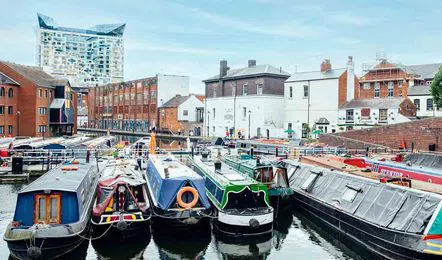Britain's Bankruptcy Crisis: A Closer Look at the Struggles of a UK City
The second-largest city in Britain is said to have declared bankruptcy and stopped all non-essential spending after receiving equal pay claims for up to £760 million ($956 million).
CNN said that the deficit resulted from issues paying equal pay claims totaling between $816 million and $954 million.
In the current fiscal year, Birmingham City Council reported a deficit of £87 million ($109 million) and a "potential liability relating to equal pay claims in the region of £650 million to £760 million." The council has "longstanding issues, including the council's historic equal pay liability concerns," according to Sharon Thompson, the deputy head of the council. Thompson also cited the Conservative Party as a source of blame, claiming that Birmingham “had £1 billion of successive Conservative governments have cut funding.”

The so-called 114 notice was issued by the Labour-controlled government in Birmingham, stopping all but necessary spending and making it the most recent council to experience financial trouble. Sharon continued by saying that despite the council's many difficulties, the city is still very much available for business. In the meantime, a representative for UK Prime Minister Rishi Sunak claimed that elected councils are in charge of managing the budget effectively.
The Rise and Fall
Crisis Ville was once an economic powerhouse, boasting a vibrant economy fueled by industries ranging from manufacturing to finance. However, over the past few decades, a series of factors converged to weaken its financial foundation.

Deindustrialization: Crisis Ville's decline can be traced back to the deindustrialization that swept across the UK in the late 20th century. The closure of factories and the loss of manufacturing jobs devastated the local workforce, leading to rising unemployment and a shrinking tax base.
Economic Inequality: As wealth inequality grew across the UK, Crisis Ville experienced its own share of disparities. While the majority of the people fought to survive, a small portion of it thrived. This exacerbated social issues and strained public resources.
Declining Infrastructure: Neglect of essential infrastructure, including transportation, education, and healthcare, further eroded the city's appeal to businesses and residents. This downward spiral diminished the city's ability to attract investment and maintain a skilled workforce.
The Breaking Point
Despite these challenges, Crisis Ville managed to muddle through, but the global economic downturn triggered by the COVID-19 pandemic proved to be the final straw. The city's reliance on industries that were especially hard-hit, such as tourism and hospitality, intensified its economic woes.

Plummeting Revenues: As businesses shuttered, unemployment surged, and tourism evaporated, Crisis Ville saw a sharp drop in tax revenues. This left the city unable to cover its mounting expenses, including public services, pensions, and debt payments.
Unmanageable Debt: Years of borrowing to maintain services and infrastructure had already saddled Crisis Ville with substantial debt. The pandemic's economic fallout made it impossible for the city to service its debts, pushing it closer to the brink of bankruptcy.
Pension Liabilities: Crisis Ville faced substantial pension liabilities, as promises made to retired city employees strained its finances. Meeting these obligations became increasingly untenable, leaving the city with a growing pension deficit.

The Bankruptcy Declaration
In a desperate move, the leadership of Crisis Ville declared bankruptcy, making it the first UK city to take such a step in recent memory. This declaration sent shockwaves through the nation and raised several crucial questions:
Legal Ramifications: Bankruptcy in the UK is uncharted territory for cities. The legal process and the consequences for creditors, pensioners, and the city's residents are still being determined through court proceedings.
Impact on Residents: Residents of Crisis Ville now face uncertainty regarding the future of essential services, infrastructure projects, and their own financial stability. The city's insolvency threatens their quality of life and property values.

National Implications: The bankruptcy of a major UK city carries significant national implications. It highlights the vulnerability of local governments and the need for a comprehensive strategy to prevent similar crises in other areas.
The Road to Recovery
While Crisis Ville faces an arduous path to financial recovery, it is not without hope. There are several potential strategies and lessons to be drawn from this situation:
Restructuring and Financial Discipline: Crisis Ville will need to implement rigorous financial discipline, cut unnecessary spending, and explore debt restructuring options to regain fiscal stability.

Economic Diversification: The city should invest in diversifying its economy, attracting new industries, and creating a resilient workforce. This will reduce its dependence on volatile sectors.
Long-Term Planning: Establishing a long-term financial plan and addressing pension liabilities are crucial steps in preventing future fiscal crises.
National Support: The UK government can provide support through grants, loans, and technical assistance to help Crisis Ville get back on its feet. Additionally, it should consider systemic reforms to prevent similar crises in other cities.

The declaration of bankruptcy by Crisis Ville is a stark reminder of the economic challenges facing cities across the UK. While the road to recovery is fraught with difficulties, it also presents an opportunity for the city to rebuild, reimagine its future, and emerge as a more resilient and prosperous community. The lessons learned from Crisis Ville's struggles should serve as a wake-up call for policymakers at all levels to address the underlying issues that have led to this dire situation and work toward a more sustainable and equitable urban future.








